Have you noticed your once vibrant cantaloupe leaves turning yellow? This can be quite disheartening, especially when you’ve invested time and effort into nurturing your plants.
Healthy foliage is not only aesthetically pleasing but also vital for the plant’s overall well-being, as leaves are the primary energy producers for the plant.
Yellowing cantaloupe leaves can be a symptom of a deeper issue impacting your plant’s growth, yield, and overall vitality.
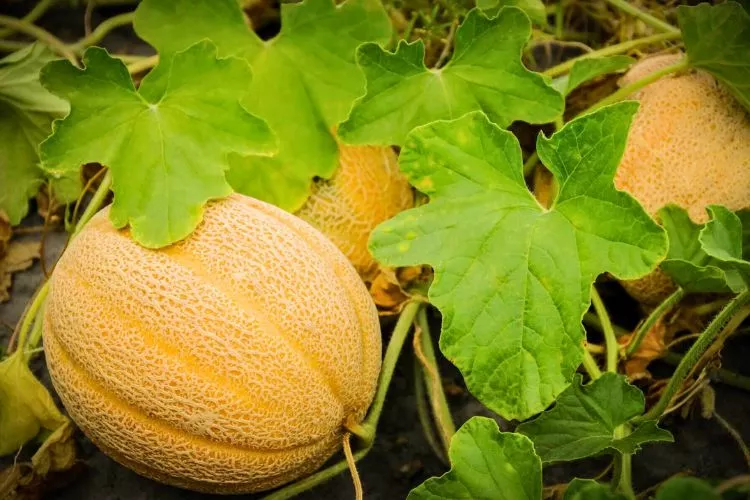
The causes of this yellowing, or chlorosis, can range from nutrient deficiencies and water stress to pests and diseases.
Understanding these issues can feel like decoding a complex botanical puzzle. But don’t worry – this comprehensive guide will demystify the causes and offer actionable solutions.
By the end of this article, you’ll have a strong grasp of restoring your cantaloupe plants to their lush, green glory. So, let’s dive in!
Table of Contents
6 Causes of Cantaloupe Leaves Turning Yellow
When it comes to gardening, a shift in leaf color can be a red flag, signaling that your plants need attention. In cantaloupes, leaf yellowing can be especially perplexing due to various potential causes.
This section aims to explore these potential triggers of cantaloupe leaves turning yellow , examining everything from nutrient deficiencies and water-related issues to the havoc that pests, diseases, and environmental factors can wreak on your cantaloupes.
We’ll dissect each cause, diving into its symptoms and management techniques, equipping you with the knowledge to identify and address these problems effectively.
With this understanding, you’ll be well on reviving your cantaloupe plants and preventing future yellowing episodes. So, without further ado, let’s uncover the culprits behind those yellowing cantaloupe leaves!
Nutrient Deficiencies
Just like us, plants require a balanced diet of essential nutrients for healthy growth. Deficiencies in certain key elements, like nitrogen, iron, and magnesium, can lead to symptoms such as yellowing leaves in your cantaloupe plants.
Let’s dig deeper into these nutrient deficiencies, their symptoms, and how to manage them to keep your cantaloupes flourishing.
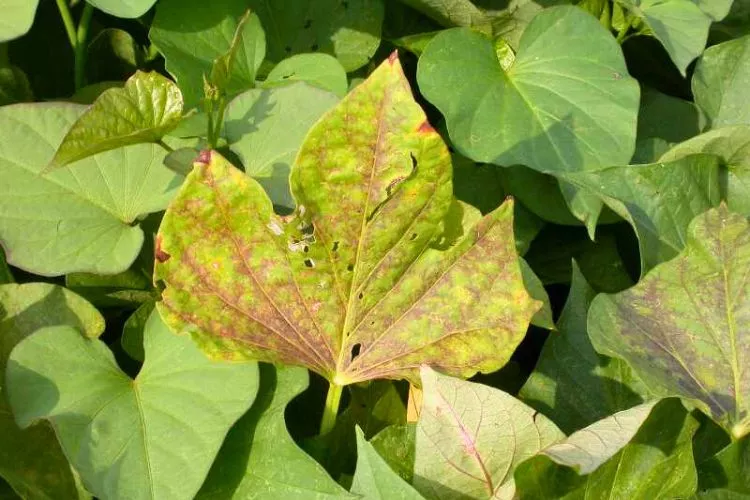
Nitrogen deficiency
Nitrogen plays a vital role in the production of chlorophyll, which gives plants their vibrant green color. A deficiency in this element can lead to yellowing, especially in older leaves.
These leaves may appear pale and could eventually drop off.
Here’s how to manage nitrogen deficiency:
- Regularly test your soil: This will allow you to keep tabs on the nitrogen levels and adjust as necessary.
- Use a nitrogen-rich fertilizer: Organic options include composted manure and alfalfa meal, while inorganic options include ammonium nitrate and urea.
Iron deficiency
Iron is critical for the creation of chlorophyll. A lack of it can lead to iron chlorosis, which first appears yellowing between the leaf veins, creating a network of green on a yellow background.
Here’s how to manage iron deficiency:
- Test your soil pH: Iron is best absorbed in slightly acidic conditions (pH 6.0-6.5).
- Add an iron supplement: Iron chelates or iron sulphate can help improve iron levels in the soil.
Magnesium deficiency
Magnesium forms the central atom of chlorophyll; thus, its deficiency can lead to chlorosis. Magnesium-deficient leaves often display yellowing between the veins, starting from the leaf edges and moving inward.
Here’s how to manage magnesium deficiency:
- Use a foliar spray: Epsom salt (magnesium sulphate) dissolved in water can be sprayed directly onto leaves.
- Adjust your soil: Adding lime or dolomitic lime to the soil can increase the magnesium content.
Remember, moderation is key when managing nutrient deficiencies. Overcompensation can lead to nutrient toxicity, which presents its own set of challenges.
Monitoring your soil regularly and responding to deficiencies in a measured way is the best approach to maintaining healthy, green cantaloupe leaves.
Overwatering or Poor Drainage
Water is vital for plant growth, but like many things in life, balance is key. Overwatering cantaloupe plants or poor drainage conditions can lead to many problems, including yellowing leaves.
Understanding the effects of overwatering, its symptoms, and the techniques for proper watering and drainage can help you foster an optimal environment for your cantaloupes.
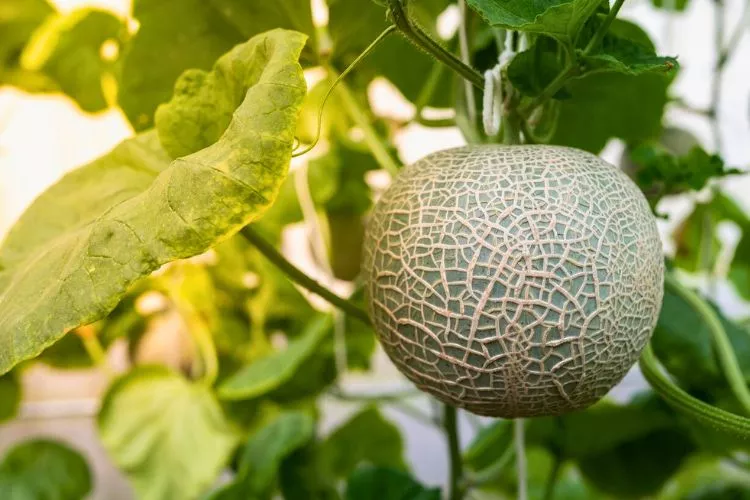
Overwatering your cantaloupe plants can essentially drown them. Plants need oxygen as much as they need water.
When the soil is constantly saturated, it can prevent oxygen from reaching the roots, leading to root rot, which can cause the leaves to turn yellow as they are not getting the nutrients they need.
Symptoms of overwatering include:
- Yellowing leaves: These may also appear soft and soggy, as opposed to the firm texture of healthy leaves.
- Stunted growth: Overwatered plants often display slow or stunted growth as the roots struggle to function properly.
- Root rot: Roots may turn brown and mushy, emitting a foul odor.
To manage and prevent overwatering:
- Check soil moisture before watering: The soil should be dry at least 1-2 inches (2.5-5 cm) below the surface before watering again.
- Water deeply, but infrequently: This approach encourages roots to grow deeper, making plants more resilient in drought.
- Improve soil drainage: Incorporating organic matter like compost or a raised bed can enhance drainage and prevent waterlogging.
Proper watering and drainage are key to keeping your cantaloupe plants vibrant and healthy. By being mindful of these aspects, you can help prevent the yellowing of leaves associated with overwatering.
Pest and Disease Infestation
Pest and disease infestations are among the most common problems gardeners face and can be the culprit behind yellowing cantaloupe leaves.
Let’s explore some common pests and diseases that may be causing havoc in your garden and learn how to manage them effectively.
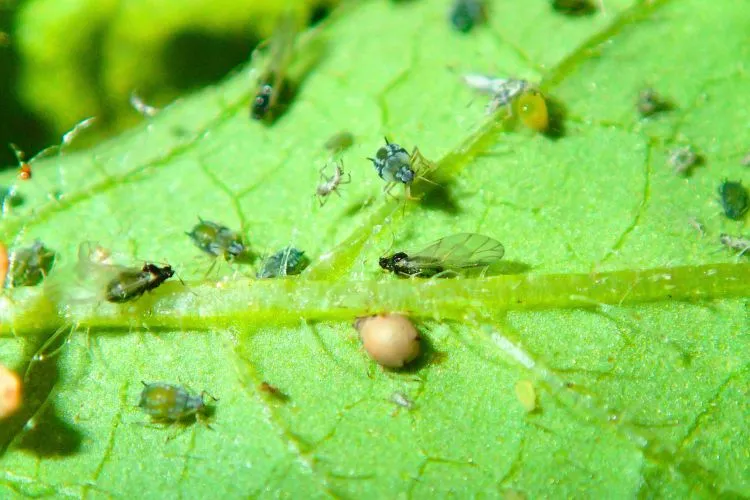
Common pests affecting cantaloupe leaves
Pests such as aphids, spider mites, and whiteflies can cause significant damage to cantaloupe leaves. Aphids and whiteflies feed on plant sap, depriving leaves of necessary nutrients and causing them to yellow and curl. Spider mites, on the other hand, can cause tiny yellow spots on leaves as they pierce the leaf cells and feed.
Here’s how you can manage these pests:
- Regular inspection: Regularly check the underside of your cantaloupe leaves for signs of these pests.
- Introduce beneficial insects: Predators like ladybugs and lacewings can help control aphid, spider mite, and whitefly populations.
- Use insecticidal soaps or oils: These can effectively kill these pests without harming beneficial insects.
Common diseases affecting cantaloupe leaves
Powdery mildew and bacterial leaf spot are two diseases that can cause cantaloupe leaves to turn yellow. Powdery mildew is a fungal disease that produces white, powdery spots on leaves, leading to yellowing and withering.
Bacterial leaf spot, caused by various bacteria, creates small, water-soaked spots that eventually turn yellow and necrotic.
Here’s how to manage these diseases:
- Practice crop rotation: This can prevent the buildup of disease pathogens in the soil.
- Remove infected leaves: If you notice any infected leaves, remove and dispose of them immediately to prevent the disease from spreading.
- Use appropriate fungicides or bactericides: Apply these treatments as directed at the first sign of disease.
Understanding the signs of pest infestation and disease in your cantaloupe plants is the first step in effective management. Early detection and intervention can make a significant difference in the health and productivity of your plants.
Lack of water/Water Stress
Just as overwatering can negatively affect your cantaloupe plants, so too can a lack of water, commonly referred to as water stress. Water is vital for plants to carry out their necessary physiological functions.
They can’t transport nutrients effectively without enough water, leading to various problems, including yellowing leaves.
Water stress in cantaloupe plants typically shows itself through drooping or wilting leaves. These symptoms may be more pronounced during the hottest part of the day. As the stress continues, the leaves may start to turn yellow, often beginning at the edges and spreading inward.
In severe cases, water stress can cause leaves to dry up and drop off, impacting the plant’s ability to photosynthesize and ultimately hindering fruit production.
Managing water stress involves regular and deep watering, particularly during dry spells. Mulching around your plants can also help retain soil moisture and reduce evaporation.
Monitoring the soil’s moisture levels and adjusting your watering practices accordingly is crucial to prevent both overwatering and underwatering, thereby maintaining the health of your cantaloupe plants.
Environmental Factors (high winds, air pollution, etc.)
Even when all the other factors like watering, nutrient supply, and pest control are on point, certain environmental elements can still impact the health of your cantaloupe plants, leading to yellowing leaves.
Factors such as high winds and air pollution can disrupt the balance of your garden’s ecosystem and stress your plants.
High winds can lead to physical damage, drying out the soil and increasing evaporation rates. All of these stress the plant, potentially causing leaf yellowing.
On the other hand, air pollution can expose your plants to harmful substances like sulfur dioxide, ozone, and particulates, which can interfere with photosynthesis and lead to yellowing or browning of leaves.
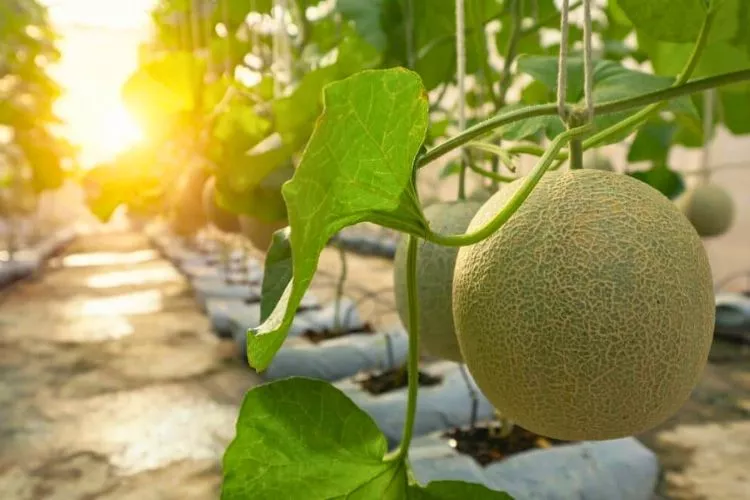
You can help protect your plants from high winds by installing windbreaks or protective coverings and keeping your soil moist.
Addressing air pollution can be trickier, especially if you live in an urban area. However, regularly rinsing your plants’ leaves can help to remove some surface pollutants, and investing in an air purifier for indoor growing spaces can also make a big difference.
Ultimately, understanding your local environment and being proactive about protection can help keep your cantaloupe plants robust and green, mitigating the risk of leaf yellowing due to environmental factors.
Inaccurate Soil pH Levels
Last but not least, the pH level of your soil can play a substantial role in the health of your cantaloupe plants.
Cantaloupes prefer slightly acidic to neutral soil, with an ideal pH range between 6.0 and 7.0. Deviations from this optimal range can lock certain nutrients in the soil, making them inaccessible to your plants.
This nutrient imbalance can lead to several problems, including yellowing leaves.
When the soil is too acidic (low pH), micronutrients like aluminum and manganese can become overly available, potentially leading to toxicity. On the other hand, when the soil is too alkaline (high pH), it can limit the availability of crucial nutrients like iron, causing deficiencies that manifest as leaf yellowing.
To manage soil pH:
- Test your soil: Regular testing will help you monitor your soil’s pH level and nutrient availability.
- Amend the soil as needed: If your soil is too acidic, consider adding lime to raise the pH. Adding sulfur or organic matter like compost or peat moss can help lower the pH if it’s too alkaline.
- Monitor plant health: Monitor your plants for any signs of nutrient deficiencies or toxicities related to pH imbalances.
Proper soil pH management is essential to maintaining healthy, green cantaloupe leaves and ensuring a successful harvest.
Symptoms of Cantaloupe Leaves Turning Yellow
Understanding the symptoms associated with yellowing cantaloupe leaves can help you quickly identify and address the underlying issue: nutrient deficiencies, water stress, or other factors we’ve discussed.
Let’s delve into the symptoms you might notice in your cantaloupe plants.
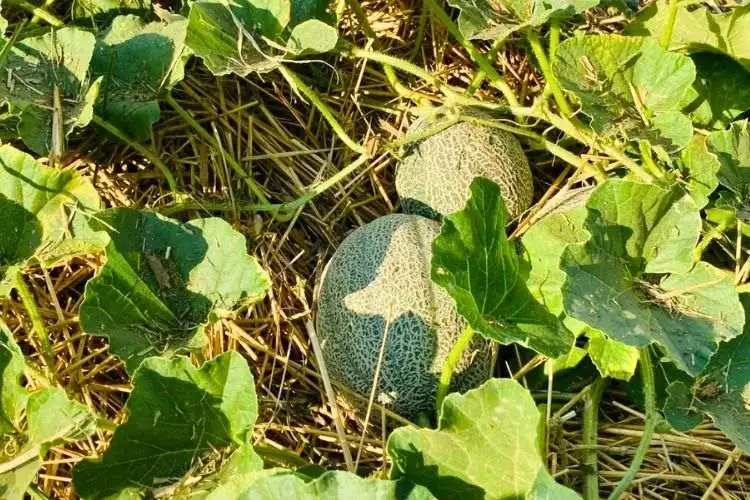
Yellowing of leaves
Yellowing of leaves, also known as chlorosis, is often the first noticeable symptom of a problem. It typically starts at the edges or between the veins of the leaves before spreading to cover the entire leaf surface.
This yellowing can be accompanied by other signs, such as leaf curling or spotting, depending on the cause. The pattern and progression of the yellowing can often provide clues to the underlying issue.
Wilting
Wilting or drooping of the leaves is another common symptom that may accompany leaf yellowing. This is often a sign of water stress, whether from overwatering or underwatering. In the case of overwatering, the leaves may also feel unusually soft or squishy, while underwatered leaves may feel dry and brittle.
Leaf drop
In severe cases, yellowing and wilting may progress to leaf drop. This is a more serious symptom indicating the plant is under significant stress. Leaf drop is often a plant’s last-ditch effort to conserve resources when struggling with a significant problem, such as a severe nutrient deficiency, disease, or extreme water stress.
Prevention and Treatment of Cantaloupe Leaves Turning Yellow
Whether you’ve already noticed yellowing leaves on your cantaloupe plants or are keen to prevent such issues from arising, understanding the appropriate preventative and treatment measures is crucial.
In this section, we’ll delve into strategies that promote optimal plant health and mitigate the factors that cause leaf yellowing, such as nutrient management, watering and drainage improvement, pest and disease control, and soil pH management.
By applying these proactive steps and solutions, you’ll be well on your way to growing vibrant, healthy cantaloupe plants. Stay with me as we navigate this important journey toward greener leaves and a fruitful harvest.
Nutrient Management
Balancing the nutrient supply is essential for the health and productivity of your cantaloupe plants. Without the right nutrients, plants can develop deficiencies leading to symptoms, including the dreaded yellowing leaves. Here’s how to ensure your plants get all the nourishment they need:
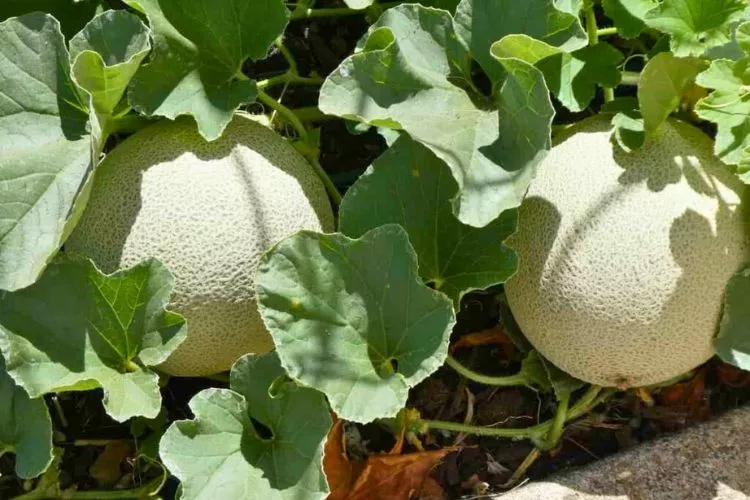
Soil Testing and Nutrient Supplementation
The first step to proper nutrient management is understanding what’s in your soil. A soil test can reveal the levels of various essential nutrients and the soil pH.
Once you know what nutrients your soil lacks, you can supplement accordingly. Numerous soil amendments available, from compost and manure to specific mineral supplements, can replenish missing nutrients.
Fertilizer Recommendations for Cantaloupe Plants
Cantaloupe plants are heavy feeders and require rich, well-drained soil. A balanced vegetable garden fertilizer, preferably organic, can be a good starting point.
Look for something with an N-P-K ratio close to 1-1-1, which stands for Nitrogen, Phosphorus, and Potassium, respectively. Following the manufacturer’s instructions, regular applications throughout the growing season can help keep your cantaloupes well-fed.
Pro Tips for Proper Nutrient Management
- Avoid Over-fertilizing: More is not always better. Over-fertilizing can lead to nutrient burn and other problems. It’s better to apply a little less than you think you might need and top up later if necessary.
- Consider Foliar Feeding: Consider a foliar feed for a quick nutrient boost, especially if your plants are already showing signs of deficiency. This involves spraying a diluted liquid fertilizer directly onto the leaves.
- Keep it Balanced: While it can be tempting to focus on the nutrient you think is lacking, it’s important to remember that plants need a balance of nutrients to thrive. Try to provide a broad spectrum of nutrients rather than overdoing it with just one or two.
By understanding and managing the nutrient needs of your cantaloupe plants, you can help prevent leaf yellowing and promote a healthy, productive garden.
Watering and Drainage Improvement
Water plays a vital role in the health of your cantaloupe plants, but getting the watering balance right can sometimes feel like a juggling act. Too much or too little water can lead to yellowing leaves and other health issues. Here’s how you can master this crucial aspect of garden care:
Determining the Appropriate Watering Schedule
The watering needs of your cantaloupes can depend on several factors, including the weather, the growth stage, and the soil type in your garden.
Generally, cantaloupes need about 1 to 2 inches (2.5 to 5 cm) of water per week. However, it’s better to water deeply and less frequently rather than give your plants a little water every day. This encourages the roots to grow deeper and makes the plants more resilient.
Techniques for Improving Drainage
Good drainage is equally as important as regular watering. Without it, water can pool around the roots, causing them to become waterlogged and deprived of oxygen. This can lead to root rot and other issues, including yellowing leaves. To improve drainage, try the following:
- Adding organic matter to your soil. This can help improve its structure, making it drain better and hold the right amount of water.
- Planting in raised beds or mounds. This can help prevent water from pooling around the roots.
- Avoiding overwatering. Even with the best-drained soil, overwatering can still cause problems.
Pro Tips for Maintaining Optimal Soil Moisture
- Use Mulch: Mulch can help conserve moisture in the soil, reduce evaporation, and maintain a more constant soil temperature. It also helps keep the roots cool, which is beneficial for cantaloupes.
- Check Soil Moisture: Use your finger to check the soil moisture before watering. If the soil’s top 1-2 inches (2.5-5 cm) are dry, it’s time to water.
- Water in the Morning: Watering in the early morning helps ensure the water gets to the roots before evaporating. It also helps prevent the growth of fungi and other diseases that thrive in damp conditions.
Mastering the art of watering and drainage can make a significant difference in the health of your cantaloupe plants, helping to keep those leaves green and vibrant while supporting a bountiful harvest.
Pest and Disease Control
Like all other garden plants, Cantaloupe plants are prone to various pests and diseases that can cause leaves to turn yellow. Effective pest and disease control involves proactive measures, appropriate treatments, and constant vigilance. Let’s dive into some techniques and options:
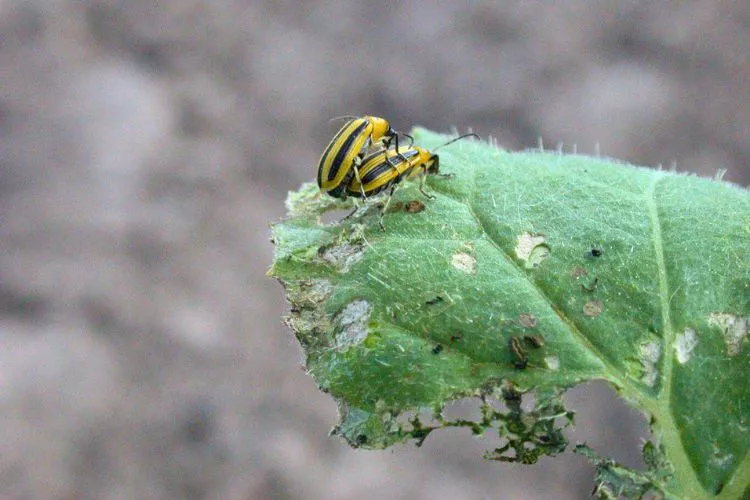
Integrated Pest Management (IPM) Techniques
Integrated Pest Management (IPM) is a comprehensive approach to pest control that focuses on long-term prevention through a combination of techniques.
It involves regular monitoring, identifying pests accurately, understanding their life cycle and behavior, and only using pesticides as a last resort. For example, introducing beneficial insects that prey on common pests, such as ladybugs, to control aphids is one of the strategies under IPM.
Organic and Chemical Options for Pest and Disease Control
Depending on the severity of the infestation or disease, you might need to resort to organic or chemical treatments. Neem oil, for example, is a popular organic option effective against many common pests and diseases. It’s non-toxic to pets, birds, fish, and even the most beneficial insects.
Chemical options, like insecticidal soaps and fungicides, can be effective but should be used cautiously due to their potential impact on the environment and beneficial insects. Always follow the manufacturer’s instructions and avoid overuse.
Pro Tips for Preventing and Managing Pest and Disease Issues
- Keep Your Garden Clean: Remove fallen leaves and other debris that could harbor pests or diseases. Regularly clean and disinfect your garden tools to avoid spreading diseases.
- Use Disease-Resistant Varieties: Some cantaloupe varieties are resistant to common diseases, which can help reduce the need for chemical controls.
- Practice Crop Rotation: This involves changing the location of your cantaloupe plants each year to disrupt the life cycle of pests and diseases and keep the soil healthy.
With these strategies in your arsenal, you’ll be well-equipped to tackle pest or disease issues head-on, preventing yellowing leaves and ensuring a healthier, more productive cantaloupe crop.
Importance of pruning for healthy plants
Pruning, a simple yet significant gardening practice, holds immense value for the health and productivity of your cantaloupe plants. While it might seem counterintuitive to cut back your plants, this practice can work wonders in terms of overall plant health and fruit yield.
Pruning helps direct the plant’s energy towards producing larger, healthier cantaloupes rather than unnecessary foliage. It also improves air circulation and sunlight penetration, which are crucial for the plant’s health and can help prevent diseases that cause the yellowing of leaves.
Moreover, it provides a chance to eliminate any diseased or infested parts of the plant, helping to prevent the spread of pests or pathogens.
When pruning cantaloupes, focus on removing dead or diseased leaves and branches and excessive vine growth. However, always be careful not to over-prune, as removing too much at once can stress the plant.
The best time to prune is in the early morning when the plant’s water pressure is highest, reducing the chances of wilting.
Use a clean, sharp tool to make clean cuts without tearing the plant tissue to prune. Disinfect your tools before and after pruning to prevent the spreading of disease. If you remove diseased plant parts, dispose of them properly and not in your compost pile.
Remember, pruning is not just about cutting back; it’s about strategic cutting that benefits your cantaloupe plants’ overall health and productivity.
With the right approach, your pruning efforts can result in lush green leaves and a bountiful harvest of succulent cantaloupes.
Proper Soil pH management
Understanding and managing soil pH can significantly influence your cantaloupe plant’s health. Soil pH is a measure of the acidity or alkalinity of the soil. This factor can greatly impact the plant’s availability and absorption of nutrients to thrive.
Cantaloupes prefer a slightly acidic to neutral soil, with a pH range of 6.0 to 7.0. If the pH drifts too far from this optimal range, it could cause nutrient deficiencies leading to yellowing leaves, among other problems.
Maintaining the proper pH starts with testing your soil. You can purchase a soil testing kit or pH meter from a gardening store or send a soil sample to a professional lab. Once you know your soil’s pH, you can adjust it if necessary.
If your soil is too acidic (pH below 6.0), you can raise the pH by adding lime (calcium carbonate). If it’s too alkaline (pH above 7.0), you can lower the pH by adding sulfur or organic matter such as compost or peat moss.
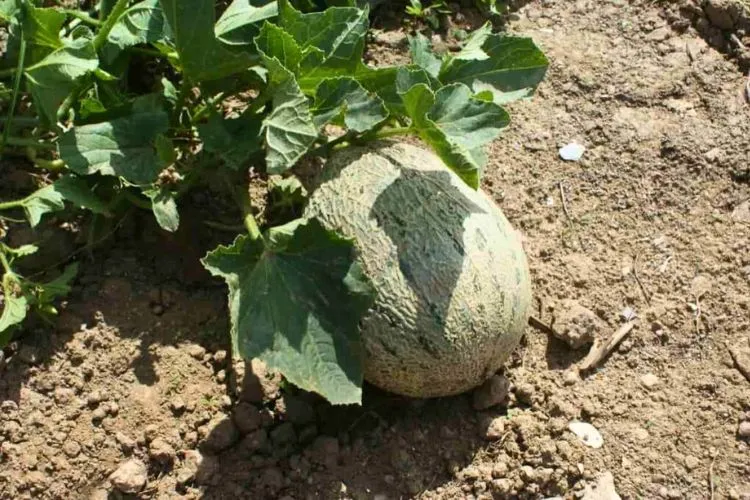
Remember to make these adjustments gradually and retest your soil after each amendment. Rapid changes in pH can stress plants.
Finally, remember that different parts of your garden may have different pH levels, especially if you’ve added amendments in the past. Therefore, testing the pH in several locations is a good idea for a more accurate assessment.
By understanding and managing your soil’s pH, you’re setting the stage for a healthy, productive cantaloupe garden free from the worry of yellowing leaves.
Pro Tips
Caring for your cantaloupe plants goes beyond basic watering, feeding, and sunlight. Here are some professional tips that can make a difference in maintaining the vibrancy of your garden and avoiding issues like leaf yellowing:
- Utilize a Moisture Meter for Accurate Watering: A moisture meter is a valuable tool that takes the guesswork out of watering. This device measures the moisture level deep within the soil, letting you know when it’s time to water. Remember, overwatering can be just as harmful as underwatering!
- Regularly Test Soil for Nutrient Deficiencies: Consistent soil testing is essential in preventing nutrient deficiencies. Soil test kits are available at garden centers and online. Regular testing will help you maintain the right balance of nutrients for healthy, green leaves and robust fruit production.
- Implement Organic Methods for Pest and Disease Control: Consider organic methods rather than resorting to harsh chemical pesticides. Natural remedies like neem oil, insecticidal soaps, or a strong blast of water can keep pests at bay. Encourage beneficial insects, like ladybugs, which are natural predators of harmful pests.
Implementing these professional tips can give you an edge in growing healthy, fruitful cantaloupe plants and, most importantly, help you swiftly address and rectify the issue of yellowing leaves.
Frequently Asked Questions (fAQs)
How can I differentiate between nutrient deficiencies and pest/disease infestations?
Nutrient deficiencies often manifest as uniform discoloration or spotting across the plant, whereas pests or diseases often cause irregular spots, wilting, or visible pest presence.
Can I use homemade remedies to treat yellowing cantaloupe leaves?
Yes, homemade remedies such as compost tea, diluted Epsom salt, or DIY insecticidal sprays can help manage nutrient deficiencies and pest infestations.
Is it possible to save a cantaloupe plant with severely yellowed leaves?
Yes, if promptly addressed. Identify the cause of yellowing—nutrient deficiency, overwatering, pests, or disease—and apply the appropriate treatment.
How often should I water my cantaloupe plants?
Water deeply every 3-4 days, but adjust based on weather and soil conditions. The soil’s top 1-2 inches (2.5-5 cm) should dry out between watering.
Conclusion:
In this comprehensive guide, we’ve journeyed through the causes of cantaloupe leaves turning yellow – from nutrient deficiencies to pests and diseases, overwatering, water stress, environmental factors, and incorrect soil pH.
We’ve shared essential insights on recognizing symptoms, prevention, and treatment strategies.
Now, the ball is in your court! It’s time to implement these remedies and grow healthy, productive cantaloupe plants. We hope that this guide has been helpful.
You can read about similar topics here on our website. Check back again soon for more.


